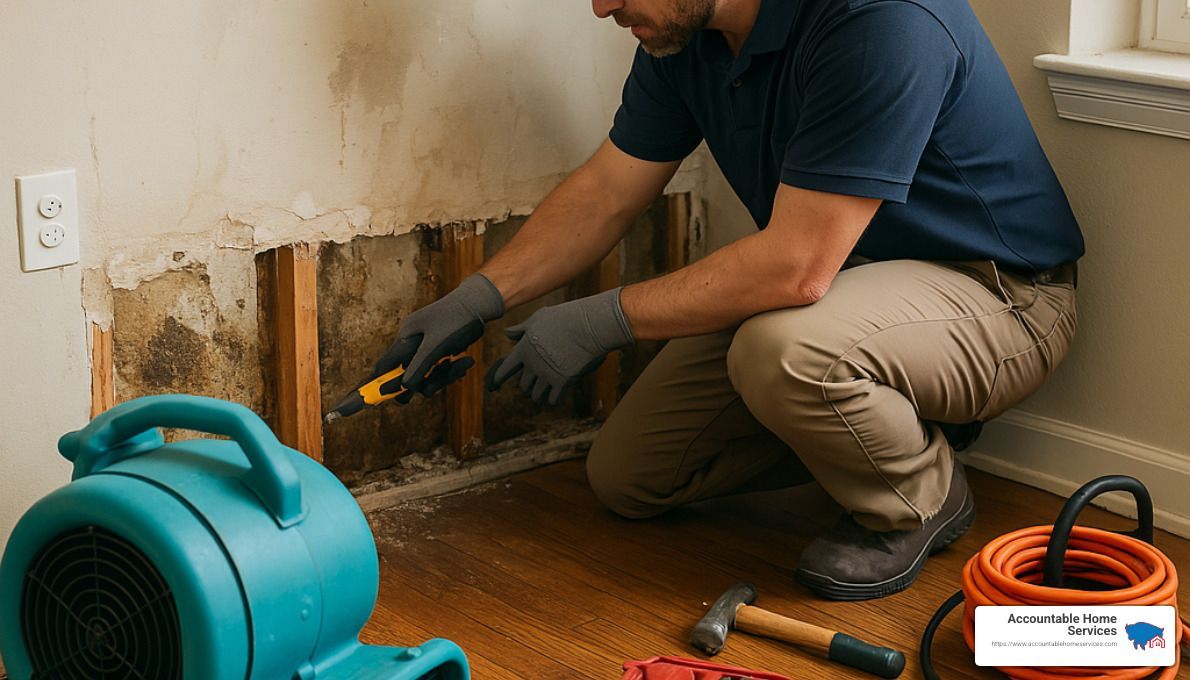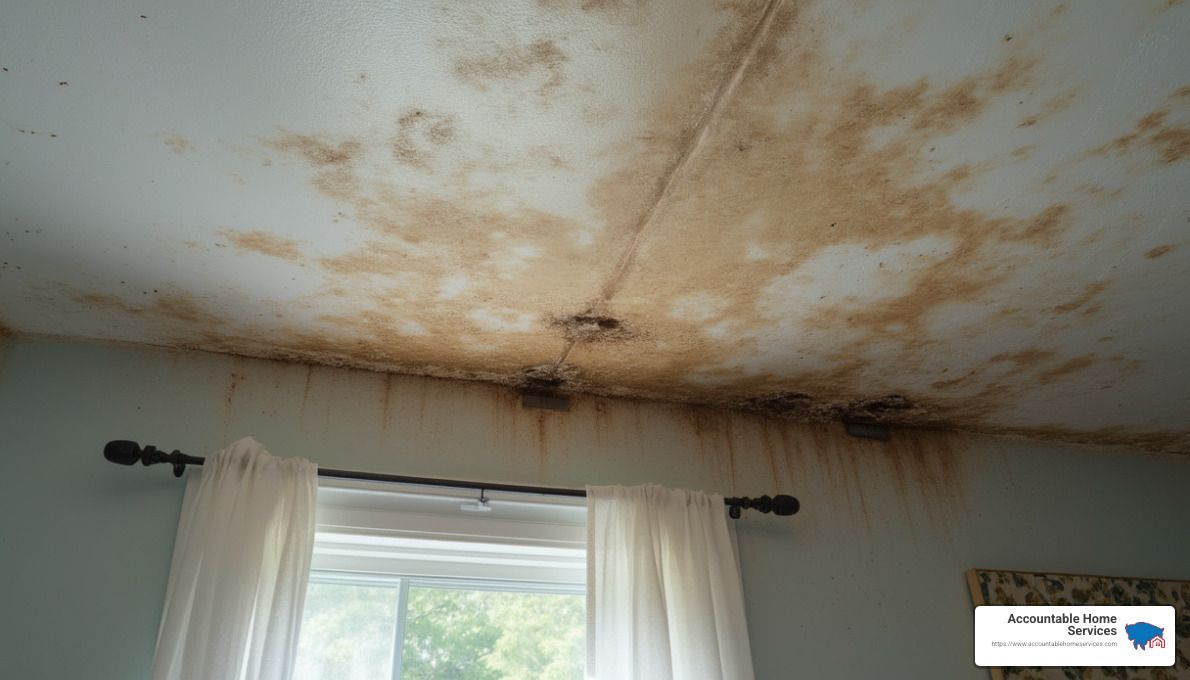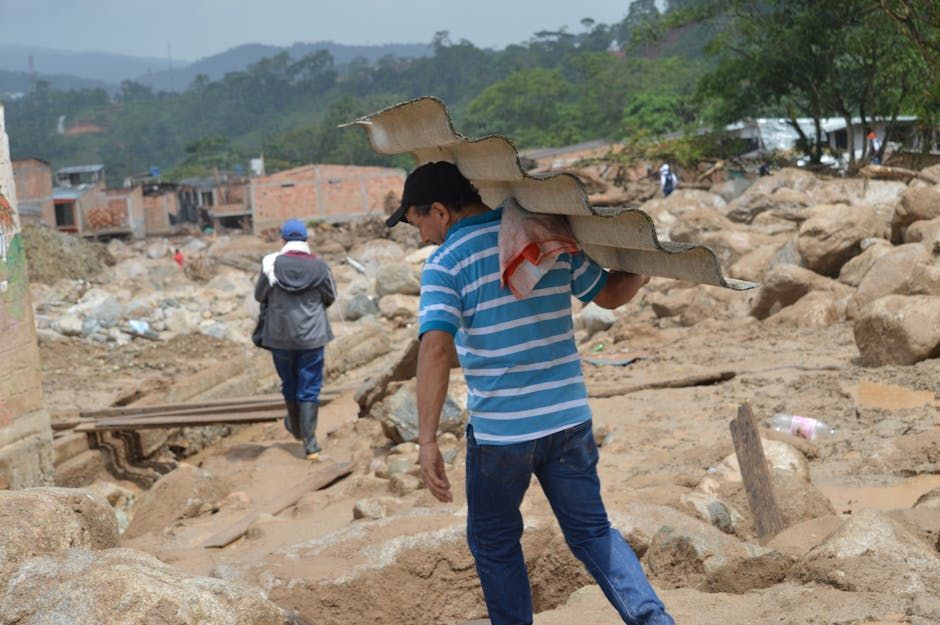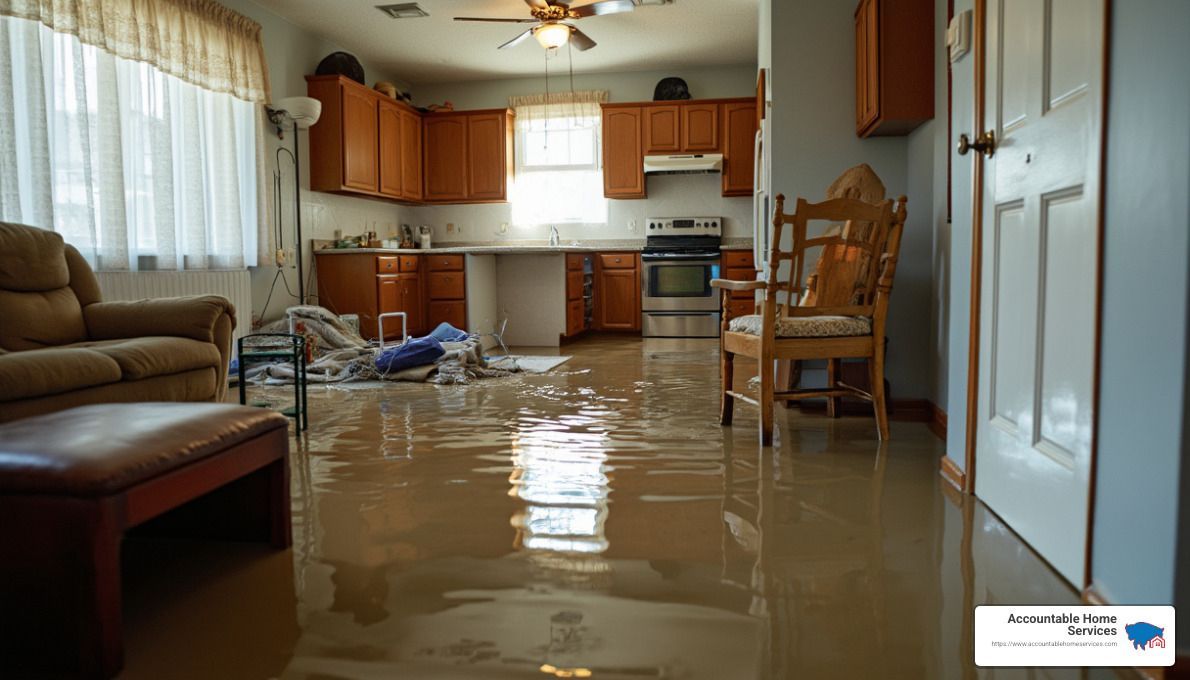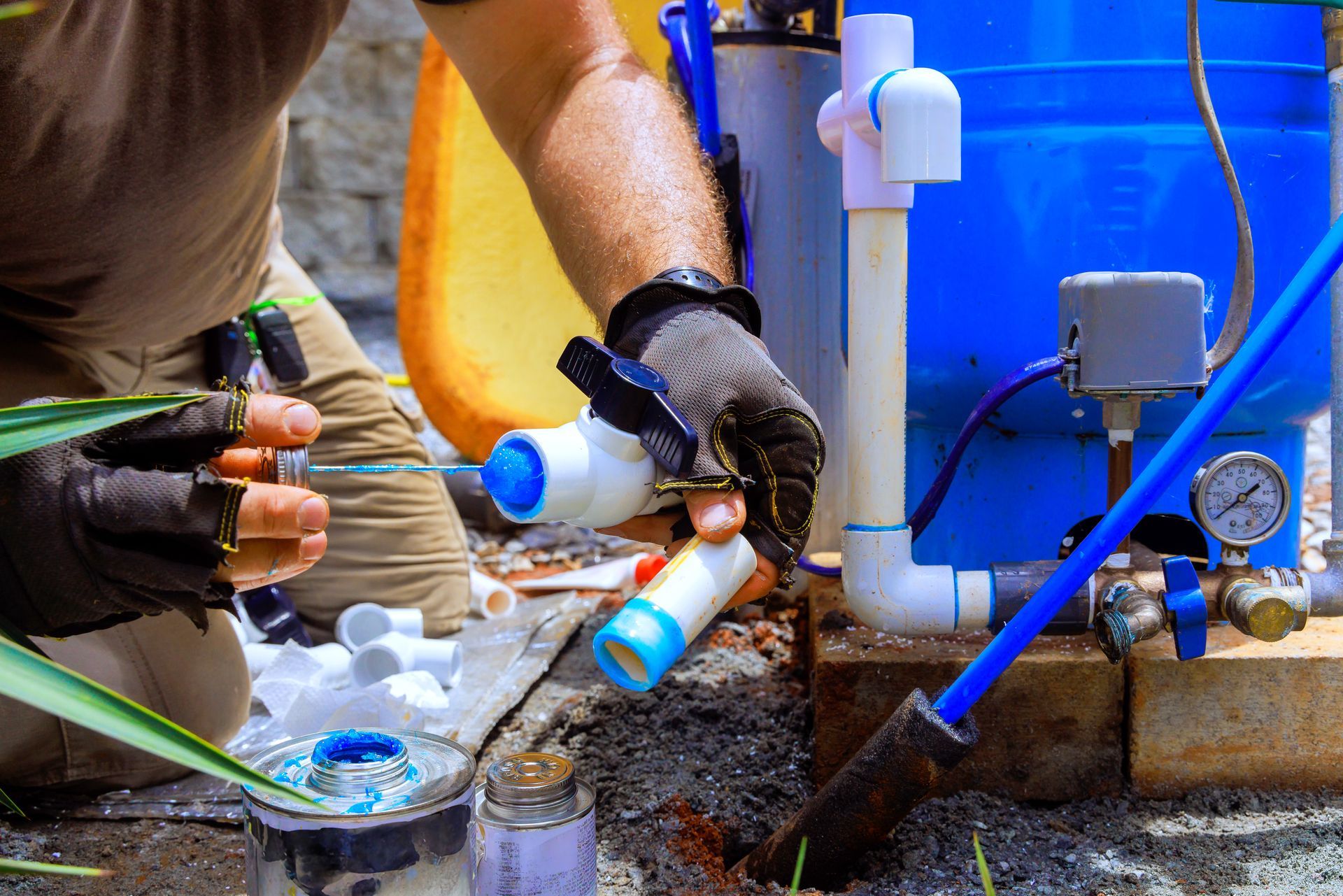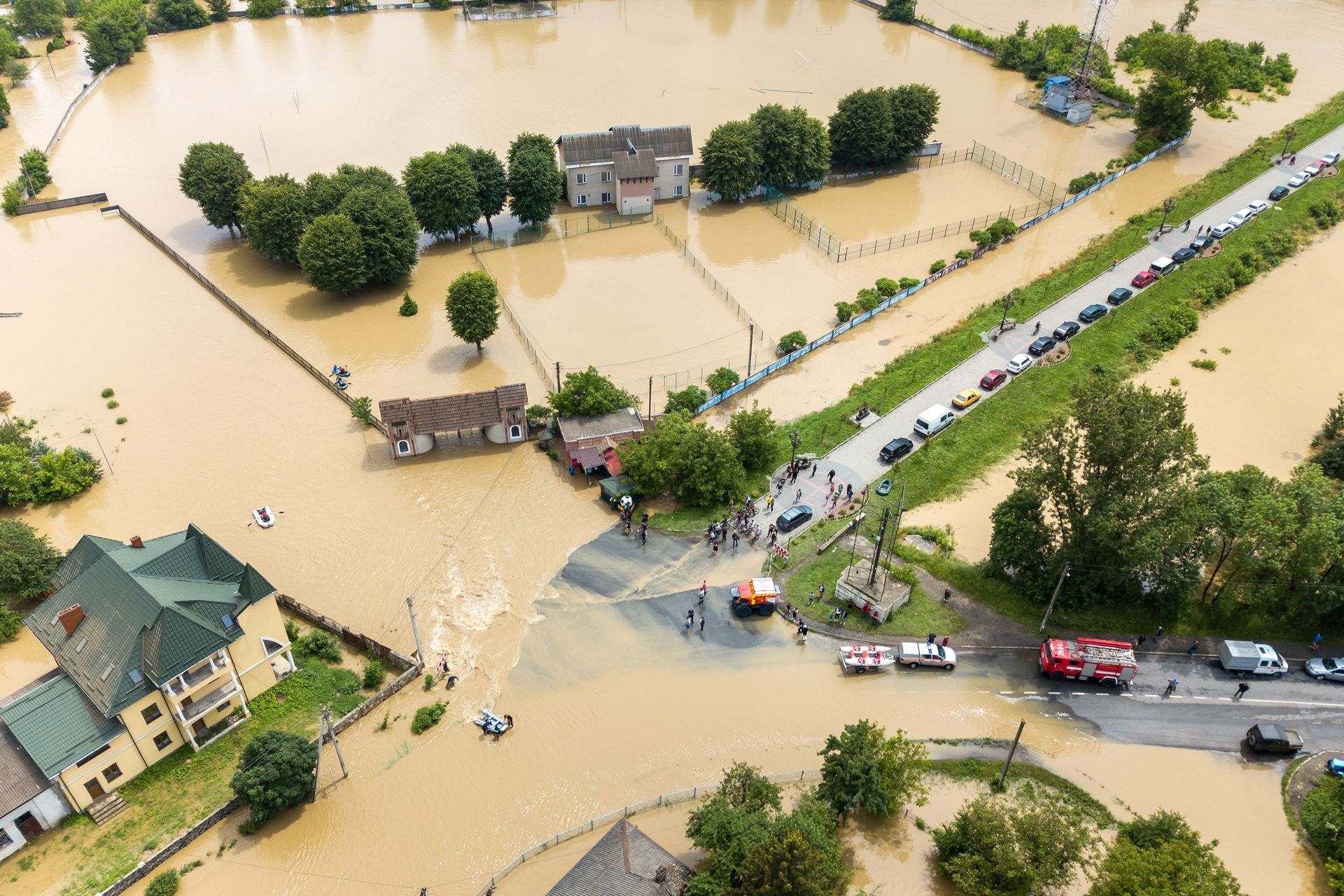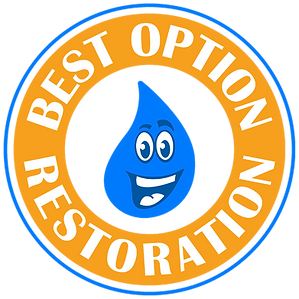Blog
Water damage floor repair isn't something you should delay. Quick action minimizes damage and saves you from costly replacements. Here's exactly what you need to know:
- Stop the water source ASAP (turn off water lines or appliances).
- Remove standing water quickly (use wet vacuums, mops, towels).
- Start drying immediately (fans, dehumidifiers, open windows).
- Assess damage severity (look for warped boards, discoloration, mold).
- Decide if you can DIY or need a professional (small areas often DIY-friendly; major damage usually requires pros).
I'm Mike Martinez, owner of Accountable Home Services, and I've spent years helping homeowners with Water damage floor repair in the Denver area. My team and I specialize in fast, reliable water damage floor repairs, helping families get back to normal after unexpected water issues.

Understanding Water Damage on Floors
Water damage on your floors can be a sneaky issue—one minute, everything seems fine, and the next, you're noticing warped boards or an odd musty smell. Simply put, water damage happens when extra moisture seeps into your flooring materials, causing deterioration and potentially leading to structural problems and health issues.
Here in Denver, our unique climate can make your floors especially prone to water damage. With dry summers and snowy winters, homes frequently face large swings in moisture levels. Those fluctuations can put significant stress on your flooring, making water damage floor repair essential for homeowners to understand and act upon quickly.
Common Causes of Water Damage
In our years of helping Denver homeowners with water damage floor repair, we've seen some common troublemakers emerge again and again. Plumbing failures are a big one—think burst pipes during freezing weather, leaky supply lines behind appliances, or faulty sink connections. Even something as small as a dripping dishwasher hose can lead to major headaches.
Household appliances, like washing machines and refrigerators, can also spring leaks. A customer in Boulder once told us after her refrigerator line leaked, "I had no idea two tiny holes in plastic tubing could cause so much damage to our beautiful floors." Unfortunately, these small leaks often go unnoticed until the damage becomes noticeable.
Roof leaks are another culprit—you might not think about them affecting your floors at first, but water traveling down your walls can reach your flooring materials. And, of course, flooding from severe storms or rising groundwater can cause immediate and obvious damage to floors. Lastly, high humidity levels, especially in basements or bathrooms, can gradually damage floors over time without homeowners realizing it.
How Different Flooring Materials React to Water
Each floor type handles water exposure in its own unique way, meaning the approach to water damage floor repair will vary based on your flooring material.
Hardwood floors are beautiful but unfortunately quite vulnerable to moisture. Wood naturally absorbs water, often within minutes or hours, causing warping, buckling, and discoloration. Ideally, your hardwood floor should stay within a moisture content of about 5-10%; anything more can spell trouble.
Laminate floors are somewhat more resistant on the surface, but not entirely immune. The biggest issue with laminate is when water seeps between the seams, reaching the fiberboard core. If that happens, the core swells, and unlike hardwood, laminate can't just be sanded down and refinished.
Vinyl floors offer a higher resistance to water. They handle surface moisture very well, but long-term standing water can still sneak underneath and cause hidden subfloor damage. It's essential to address any standing water quickly, even with vinyl flooring.
Tile floors, like ceramic or porcelain, are incredibly water-resistant on their own. However, their weakness lies in grout lines. If these grout joints are compromised, water can get through to the subfloor, potentially causing unseen structural damage beneath your tiles.
As our technical director regularly tells clients, "Water damage affects floors on three distinct levels: the surface finish, the structural integrity of the flooring itself, and the subfloor or fastening system beneath it." Understanding this helps homeowners recognize that even minor water damage can be deeper than it first seems, emphasizing why professional water damage floor repair can be crucial.
To learn more about maintaining wood flooring specifically, check out the latest research on water-damaged wood floors from industry experts.

Identifying Signs of Water Damage in Your Flooring
Catching water damage early can make a huge difference in preventing costly repairs and lasting headaches. The faster you spot the issue, the quicker you can address the problem and restore your floors to their former beauty. Knowing exactly what to look for makes all the difference in effective water damage floor repair.
Visual Indicators
First, let's talk about visual cues. These are often the most obvious and easiest signs to spot.
You might notice discoloration, like dark patches, stains, or areas with a sudden change in color. This is a clear sign that moisture has managed to penetrate your flooring materials.
Another common indicator is warping or cupping, where the edges of hardwood or laminate boards start to curve upwards, making the center appear lower. The opposite issue—called crowning—can also occur, with boards swelling in the center, pushing it higher than the edges.
In more serious cases, you might even see buckling, which happens when the moisture causes the flooring to detach entirely from the subfloor, creating raised, uneven areas. Other times, moisture leads to noticeable gaps between boards, as the wet wood expands and then contracts upon drying.
Also, keep an eye out for peeling or bubbling floor finishes—especially common in laminate and hardwood floors—or white and dark stains, indicating water intrusion beneath your floor's surface coatings.
Non-Visual Signs
Not every sign of water damage is visible at first glance. Sometimes, your nose or foot can alert you to hidden trouble.
If you notice persistent musty odors, that could mean mold or mildew has begun to set in underneath. Don't ignore these smells—they're often an early warning signal, especially in enclosed spaces like bathrooms or basements.
When you're walking around your house, pay attention to the feel beneath your feet. Soft or spongy areas can indicate subfloor damage from moisture, even if the flooring itself looks normal. Similarly, new and unexplained squeaking or creaking noises can mean moisture has affected your subfloor or flooring fasteners.
And don't forget your monthly water bill. An unexpected spike in your water usage could suggest a hidden plumbing leak that's hurting your floors without you realizing it.
Using Moisture Detection Tools
Sometimes, our eyes and noses just aren't enough—particularly when moisture hides beneath the surface. That's why at Accountable Home Services, our technicians rely on advanced tools during our water damage floor repair assessments.
We regularly use digital moisture meters that accurately measure moisture levels deep within flooring materials. These handy devices can reveal hidden moisture pockets invisible to the naked eye.
We also employ thermal imaging cameras to detect trapped moisture and temperature differences behind walls, under floors, and beneath surfaces. Combined with hygrometers, which measure relative humidity in your home's air, these instruments provide a complete picture of the moisture situation in your home.
As our lead technician often says to Denver-area homeowners, "You'd be surprised how a dry-looking surface can hide significant moisture underneath. That's why we always take baseline readings before starting any repair work."
By understanding these signs and acting promptly, you'll stay ahead of potential damage, protecting your home—and your wallet—from unnecessary stress and expenses down the line.
Immediate Steps to Take When You Find Water Damage
Finding water damage feels like a punch to the gut—trust me, we've seen Denver homeowners go through this more times than we'd like. But here's the good news: the quicker you act, the better your chances of saving your beautiful floors. Quick action can make the difference between a manageable water damage floor repair and a complete flooring replacement.
1. Stop the Water Source
Before you do anything else, your first job is to turn off the source of the water. If a burst pipe or plumbing issue is causing trouble, shut off the main water supply immediately. For appliance leaks like a dishwasher or fridge, find the appliance's own water shutoff valve and close it.
It’s also a great idea (if it’s safe to do so) to move furniture and belongings away from the affected area. Don't forget to quickly grab your phone and snap some photos of the damage right away—this will be very handy later, especially if you'll be dealing with insurance claims.
One of our recent clients in Westminster, Karen, told us that knowing exactly where her water shutoff valves were located helped save her hardwood floors when her dishwasher sprung a leak. She acted fast and limited the damage significantly.
2. Ensure Safety First
I can't stress this enough: safety comes first. If there's standing water, water and electricity are a dangerous combination. Before you step into any wet area, make sure you turn off electricity to that part of your home to avoid risk of electric shock.
Also, if you suspect the water may be contaminated—like from flooding or sewage backup—wear protective gear such as gloves, boots, and masks. Take a moment to inspect for structural issues too, before stepping onto severely water-damaged floors.
3. Remove Standing Water
Once you've ensured your safety, it's time to tackle that standing water. Every minute counts— the longer water sits, the deeper into your floors and subfloor it seeps.
Grab a wet vacuum if you have one handy—it’s your best friend in this scenario. If not, towels and mops can get the job done in a pinch. Remove wet rugs, carpeting, or any floor coverings immediately, as they trap moisture and make drying tougher.
We once had a homeowner in Lakewood who soaked up gallons of water using towels before we arrived. Believe me, his quick thinking saved him from a much bigger headache.
4. Begin Drying Process
Starting the drying process early is absolutely crucial for effective water damage floor repair. To get air flowing and moisture drying, position fans strategically around the damaged area. Fans help circulate air and speed up evaporation.
But don't stop there—use dehumidifiers to actively remove moisture from the air. If the weather outside is dry, open up some windows and doors to help your floors breathe.
If necessary, remove baseboards carefully to let air circulate behind walls (moisture loves hiding there!).
"Quick action here can save your floors from more extensive damage. In fact, we've seen cases where homeowners who acted within the first hour were able to save their hardwood floors with minimal long-term effects." - Water Damage Restoration Team, Accountable Home Services
5. Monitor the Drying Progress
Drying your floors properly usually takes around 3-5 days, but this timeframe depends on several things: the type of flooring, the extent of water damage, your home's indoor environment, and the quality of drying equipment you're using.
You'll want to check moisture levels daily—a simple digital moisture meter can help you track this. Your goal is to get moisture readings back down to normal levels (typically between 5-10% for wood floors).
If you follow these steps and stay vigilant, you'll give yourself the best possible chance of minimizing damage. Still, it's never a bad idea to get professional advice—especially if the damage seems severe or you're unsure about anything.
At Accountable Home Services, we're always here to help. Don't hesitate to reach out if you need professional support or a free assessment from our experienced team.
Water Damage Floor Repair: Step-by-Step Guide
After you've tackled the immediate emergency response, it's time to roll up your sleeves and move forward with water damage floor repair. You might be wondering, "Where do I begin?" Let's break this down step-by-step—whether you're a DIY homeowner or leaning towards professional help, we've got you covered.
Assessing the Extent of the Damage
Before diving into repairs, it's crucial to clearly understand the damage you're facing. At Accountable Home Services, our assessment process begins with a comprehensive visual inspection. We'll examine every inch of the affected flooring, checking carefully for moisture levels with professional-grade moisture meters. A thorough subfloor evaluation is also essential since unseen structural damage can create long-term headaches down the road. If the water has been standing for more than a day or two, mold testing may also become necessary to protect your family's health.
Thinking of doing a DIY assessment first? Smart move! Start by using a consumer-grade moisture meter available at most hardware stores. Tap or press gently across your floors, checking for soft spots or unusual give—these areas often indicate hidden damage. Notice any musty odors or visible mold growth? Both are clear signs you might need professional guidance. And don't be shy about removing a few floorboards to inspect beneath; better to catch subfloor issues early than find them halfway through repairs!
This initial assessment will help you decide whether to repair or replace your flooring. Minor issues like surface staining or slight warping usually respond well to repair techniques. Moderate damage, such as limited buckling or mold growth, might require replacing a section of flooring. But for extensive buckling, widespread mold, or structural concerns, replacing the entire flooring is often the safest—and ultimately, most cost-effective—option.
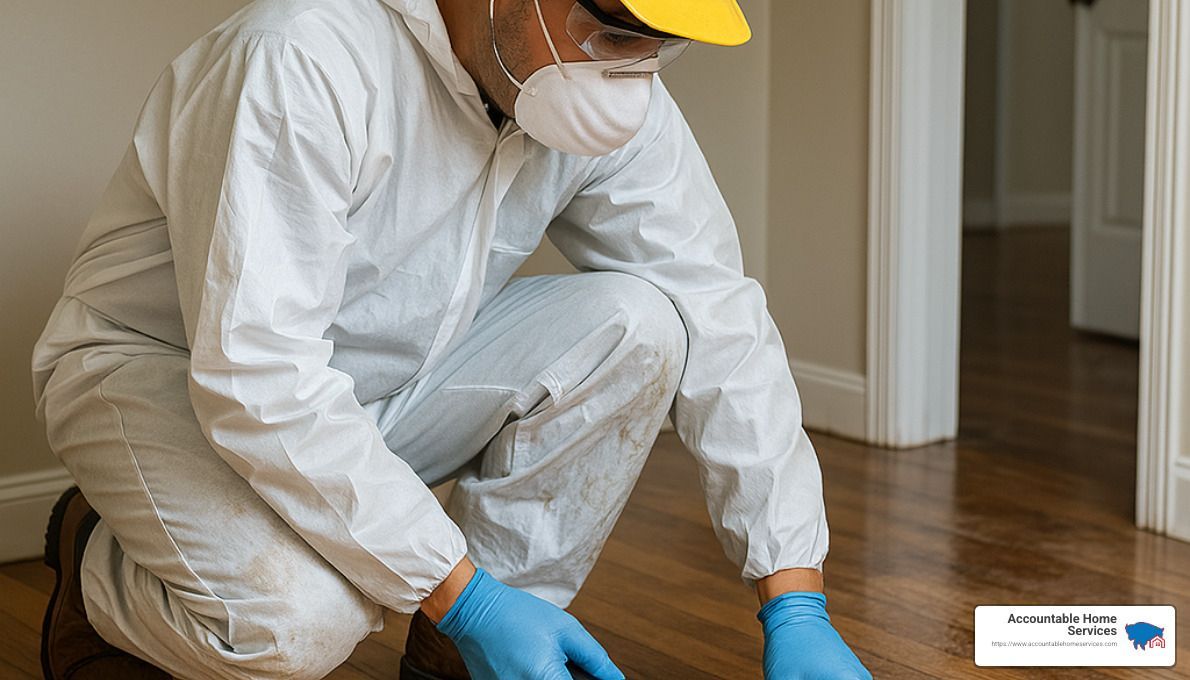
Repairing Water-Damaged Hardwood Floors
When it comes to hardwood flooring, quick action and proper drying are your best friends. Once moisture levels have returned to normal (between 5-10%), minor damage can often be addressed easily with sanding and refinishing. Begin with coarse grit sandpaper (around 60-80 grit), gently removing stains and warping. Gradually move to finer sandpapers (100-120 grit, then 150-180 grit) until the wood feels smooth and even. After sanding, carefully match and apply your wood stain, then finish with two or three coats of polyurethane sealant.
For more serious hardwood damage—like severe warping or structural instability—the process gets a bit more involved. You'll need to remove the visibly damaged boards and assess the subfloor beneath, repairing it as necessary. Install new hardwood boards that exactly match your existing flooring's species, style, and dimensions. Carefully weaving in these new planks alongside the old ones creates a seamless and natural look when finished. Finally, sand, stain, and seal the entire repair area for consistency.
Repairing Water-Damaged Laminate Floors
Unfortunately, laminate flooring isn't as resilient as hardwood when facing water damage. Laminate is made of fiberboard, which tends to swell and warp irreversibly when wet. Typically, damaged laminate planks cannot be refinished or repaired—they must be replaced.
Start by removing the baseboards around your damaged flooring. For click-lock laminate flooring, carefully disconnect and remove planks, starting from the wall closest to the damage and moving inward. With glued laminate, you may need to carefully cut out the damaged sections. Don't forget to inspect your underlayment; replace it if wet or moldy, and allow everything to dry completely.
When installing replacement laminate planks, use matching products from your flooring brand, if possible. That way, the new sections blend seamlessly. After installation, reattach your baseboards and admire your handiwork—a job well done!
Dealing with Subfloor Damage
When water damage reaches the subfloor, it's time to get serious. Common signs of subfloor issues include soft or spongy areas underfoot, visible sagging, or persistent musty smells—even after cleaning. If you notice these indicators, don't delay addressing them.
Repairing your subfloor involves carefully removing flooring above the damaged area, cutting out compromised sections of plywood or OSB, and thoroughly drying and treating the underlying floor joists. Treat any mold growth with antimicrobial solutions to ensure your family's safety.
Next, cut and install new subfloor material, carefully securing it to your floor joists with adhesive and screws. If needed, apply a self-leveling underlayment to create a smooth, even foundation for your replacement flooring. Because dealing with subfloors requires precise measurements and structural know-how, don't hesitate to call in professionals like Accountable Home Services to ensure a job done safely and accurately.
Repairing Water-Damaged Vinyl Floors
Vinyl flooring repair varies depending on your type, but it's generally straightforward. For sheet vinyl, the damaged section is neatly cut out, and replacement vinyl is carefully measured, cut, and adhered into place. Don't forget to use a vinyl seam sealer for a tight, waterproof finish.
With luxury vinyl plank (LVP) or tile, you'll remove damaged pieces and replace them with matching products. Click-lock planks can be easily disassembled and replaced piece-by-piece, while glued-down planks or tiles require a bit more finesse. Ensure the subfloor is entirely dry and clean the area thoroughly before replacing damaged sections.
Whichever type of flooring you have, taking prompt action, carefully assessing the damage, and following these steps will go a long way toward restoring your floors—and peace of mind! If you're ever uncertain or simply don't have the time and tools to handle water damage floor repair, our friendly team at Accountable Home Services is always here, ready to lend a helping hand.
Preventing Future Water Damage to Your Floors
Congratulations! You've tackled the tough task of water damage floor repair, and your floors are looking great again. But now comes the next important step—making sure this doesn't happen again. Let's walk through some practical ways you can protect your home from future water damage.
Regular Maintenance and Inspections
Think of home maintenance as your home's regular health check-up—it helps catch small issues before they become major headaches. To avoid future water damage, make it a habit to inspect your plumbing connections every six months. Don't forget to pay special attention to those sneaky appliance hoses behind your washing machine, dishwasher, and refrigerator, checking them at least once a year.
After a heavy rain or snowstorm (common for us here in Denver), be sure to look around your ceilings and walls for new water stains—a sign your roof might have leaked. And since Colorado's climate can fluctuate, it's wise to keep an eye on your home's humidity levels, aiming for a comfortable range between 30% and 50%.
Upgrading Plumbing and Appliances
When it comes to preventing future water mishaps, a few smart upgrades can go a long way. Swapping out those flimsy plastic appliance hoses for sturdy braided stainless steel ones can significantly reduce the risk of leaks. For even greater peace of mind, replacing plastic water supply lines with durable copper or PEX piping is a worthwhile investment.
One of our customers here in Denver recently shared a great tip: after restoring their kitchen floors from a fridge leak, they installed a smart water leak detector. Six months later, the device caught a small dishwasher leak early enough that it prevented any flooring damage. Consider installing similar leak detection systems near your own appliances, and don't overlook handy solutions like dishwasher leak pans—small investments that can save you major headaches.
Proper Sealing and Waterproofing
Just like putting on a raincoat before going out in a storm, sealing your floors adds a protective layer against moisture. For hardwood floors, reapplying wax sealants annually and refreshing polyurethane coatings every three to four years will keep your flooring looking beautiful and functioning well.
Tile floors also deserve attention—remember to seal grout lines every one to two years to prevent water seepage. High-risk areas like entryways, kitchens, and bathrooms benefit from waterproof mats, which act as another line of defense against potential spills and drips.
Controlling Humidity
Here in Colorado, our weather swings can create humidity challenges inside homes that lead to unexpected moisture issues. Using dehumidifiers in naturally damp areas like basements and crawl spaces can help balance humidity levels and prevent creeping water damage.
In bathrooms, a properly installed exhaust fan is an essential tool for whisking away shower steam before it can damage your floors or walls. And for year-round control, consider a whole-home humidification system designed specifically to maintain optimal indoor humidity, keeping your floors and family more comfortable.
Installing Early Warning Systems
Technology is your ally in proactively preventing water damage. A smart water sensor can instantly alert your phone at the slightest hint of moisture, giving you valuable time to respond before it becomes a bigger issue. Even better, automatic water shutoff valves can detect leaks and shut down the water supply quickly, which is particularly useful when you're away from home.
Our prevention specialist at Accountable Home Services often shares this insightful statistic with homeowners: "Homes with leak detection systems typically experience 70% less severe water damage incidents compared to homes without them." When you compare the modest upfront cost of these systems to the potential expense and hassle of extensive water damage floor repair, it really becomes clear—they're a smart investment for any Denver homeowner.
By incorporating these simple but effective practices into your routine, you'll be well-equipped to avoid future water damage headaches. At Accountable Home Services, we're always here to help with expert advice and professional support. For more details on protecting your home, visit our page on Water Damage Restoration Services.
Frequently Asked Questions about Water Damage Floor Repair
Dealing with water damage floor repair can raise plenty of questions for homeowners in the Denver area. At Accountable Home Services, we've seen it all—and we understand how stressful these situations can be. Let's tackle some of the most common questions our customers ask, so you’ll feel confident knowing exactly what steps you need to take next.
How long does it take for water to damage floors?
Water can begin damaging your floors almost as soon as it makes contact, which is why immediate action is so important. The exact timeframe for noticeable damage depends heavily on your flooring type:
- Hardwood floors start absorbing moisture almost instantly and can show visible damage within just a few hours.
- Laminate floors might resist water on the surface for an hour or two, but once moisture seeps between the seams, swelling and warping can quickly follow.
- Vinyl floors offer better water resistance initially, and may withstand surface moisture for up to 24 hours or more. However, water can still seep underneath, causing hidden subfloor damage.
- Subfloors, the structural foundation beneath your finished flooring, typically begin showing damage after about 24-48 hours of continuous moisture exposure.
As our restoration experts often share, if water has been soaking into your flooring for more than a day, replacement rather than repair may become necessary.
Can I repair water-damaged floors myself?
This depends largely on the extent of the damage and your comfort level with DIY projects. Simple, surface-level problems like small water stains or minor discolorations (under about three square feet) are usually manageable for most homeowners. However, if you notice signs of mold, structural instability, or extensive damage spread across several rooms—or if you suspect contaminated water (like sewage or floodwater)—it’s best to call in professional help.
Many homeowners initially attempt DIY repairs, only to find lingering issues such as mold growth or recurring moisture problems later on. Our lead technician explains it best: "Proper moisture testing and thorough drying are absolutely essential. These are steps that DIYers often underestimate, leading to bigger headaches down the road."
What are the potential health risks associated with water-damaged floors?
Water-damaged floors aren't just unsightly—they can also pose real health concerns for your family. One of the biggest risks is mold growth, which can begin as quickly as 24-48 hours after exposure to moisture. Mold spores can trigger respiratory issues, asthma flare-ups, and allergic reactions, especially in sensitive individuals.
Beyond mold, water damage poses bacterial contamination risks if the moisture comes from floodwater or sewage backup. Structural weakening of flooring and subfloors also creates safety hazards, increasing the chance of slips, falls, or even collapse.
One Boulder client learned this after a minor leak she believed was resolved. Unfortunately, hidden mold growth beneath her flooring led to respiratory problems for her young son, requiring professional remediation to fully address the issue.
How much does water damage floor repair typically cost?
As you might imagine, the cost of water damage floor repair can vary quite a bit depending on several factors, such as the flooring material, extent of the damage, and whether subfloor repairs are needed. Here in the Denver metro area, costs typically range from:
- Minor repairs (like fixing small spots or stains) costing $200-$500.
- Moderate damage repairs, involving partial room repairs or plank replacements, ranging from about $800-$3,000.
- Extensive damage, including complete flooring and subfloor replacement, costing $3,000-$10,000 or more depending on room size and materials used.
Many homeowners insurance policies will cover sudden and accidental water damage, such as burst pipes or appliance leaks. However, gradual leaks or maintenance-related issues might not be covered, so always check your policy carefully and document damage promptly to increase your claim's success.
How long does the drying process take?
Proper drying is crucial before starting any repairs and is typically done in two phases. Surface drying can usually be completed within about 12-24 hours if you use professional-grade drying equipment like high-powered fans and dehumidifiers. Complete structural drying—the process of removing moisture from deeper layers of flooring and subfloors—usually takes around 3-5 days.
Several factors can influence drying times, including how saturated your flooring became, the type of materials involved (hardwood typically takes longer than vinyl), indoor humidity, temperature, and the quality of equipment used. Our Technical Director, Daniel Elbrecht, covers this in-depth in our helpful video "Can You Save Water Damaged Flooring?", where he walks homeowners through identifying and addressing water damage on floors.
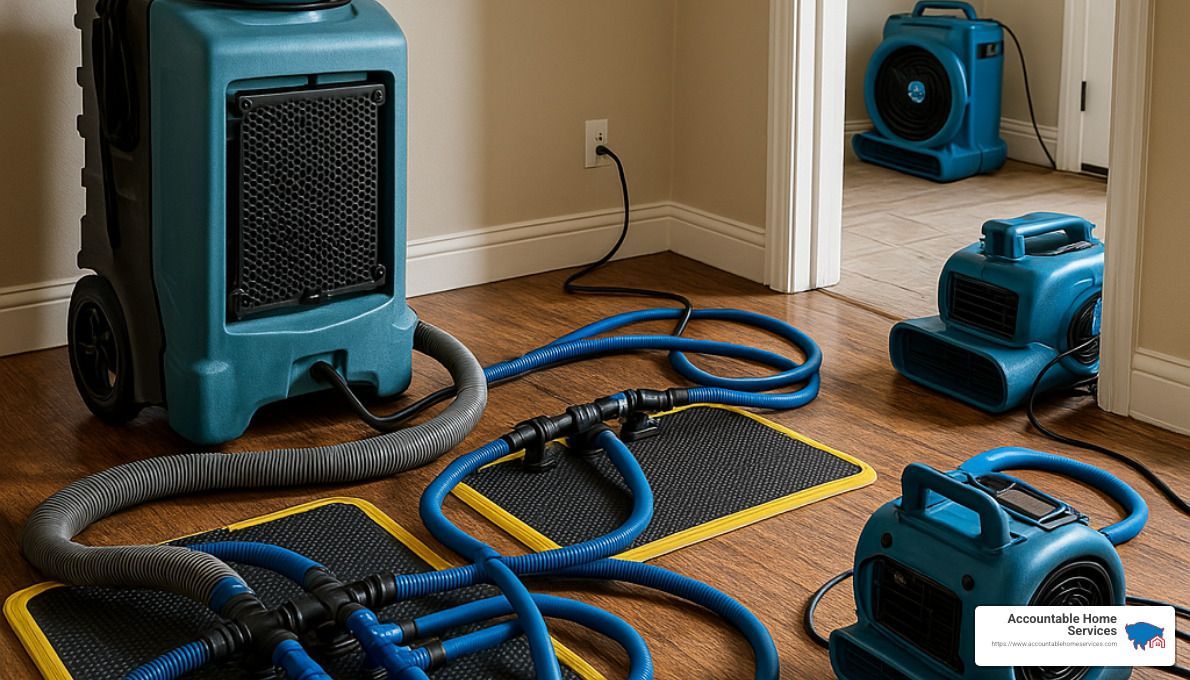
Will my insurance cover water damage to my floors?
This is one of the most common concerns homeowners have. Insurance coverage for water damage typically depends on the cause and your specific policy terms. Most standard homeowners insurance policies will cover sudden and unexpected events, such as burst pipes or appliance malfunctions. However, gradual water issues caused by neglect or ongoing leaks might not be covered.
If you're facing water damage, remember these important tips to improve your chances of an insurance claim approval:
- Take photos and videos right away to document the damage.
- Report the damage promptly to your insurance company.
- Work with a certified restoration professional who can provide detailed documentation, moisture readings, and itemized repair estimates.
At Accountable Home Services, we simplify this process for you by working directly with your insurance provider. Our goal is always to make your restoration experience as stress-free as possible, helping you get your home back to normal quickly.
Still have questions or need immediate help with water damage floor repair? Reach out to our friendly, experienced team at Accountable Home Services—we’re here to help restore your peace of mind.
Conclusion
Dealing with water damage floor repair can seem daunting at first, but it doesn't have to mean permanent damage to your beautiful floors. Quick action, accurate assessment, and choosing the right restoration methods for your flooring type can make a huge difference. The key is acting promptly to avoid further damage and reduce repair costs.
Denver homeowners face unique challenges with our climate: dry summers and snowy winters mean moisture management is especially critical. While our dry environment can actually help speed up the drying process, ensure that floors reach appropriate moisture levels before beginning repairs. Otherwise, you might accidentally do more harm than good.
At Accountable Home Services, we've spent years helping Denver-area homeowners—including those in Broomfield, Westminster, Thornton, and beyond—restore their water-damaged floors. Our certified technicians use advanced moisture detection tools and proven restoration techniques, carefully evaluating each situation to pinpoint the most effective solution.
Our goal isn't just restoring your floors—it's restoring your peace of mind. As a local, family-owned company, we understand how stressful water damage can be for families. That's why we offer 24/7 emergency response and work directly with your insurance, simplifying the claims process and getting your home back to normal quickly.
Whether you've got hardwood that needs careful sanding and refinishing, laminate planks that require precise replacement, or subfloors needing structural repairs, our team has the skills and equipment to handle it all. And because prevention is just as important as the repair itself, we also provide practical advice and advanced leak detection systems to reduce future risks.
When it comes to water damage floor repair, remember these important guidelines: act fast, dry thoroughly, assess carefully—including all flooring layers and the subfloor—choose suitable repair techniques, and take proactive steps to avoid future water incidents.
Water damage doesn't have to spell disaster for your home. With prompt, professional attention, your floors can be fully restored—often looking and performing even better than before.
Looking for professional help with water damage floor repair in Denver? Accountable Home Services is ready and waiting to help you restore your home and protect your investment. Reach out to our water damage restoration professionals today for a free assessment, expert guidance, and the peace of mind you deserve.

